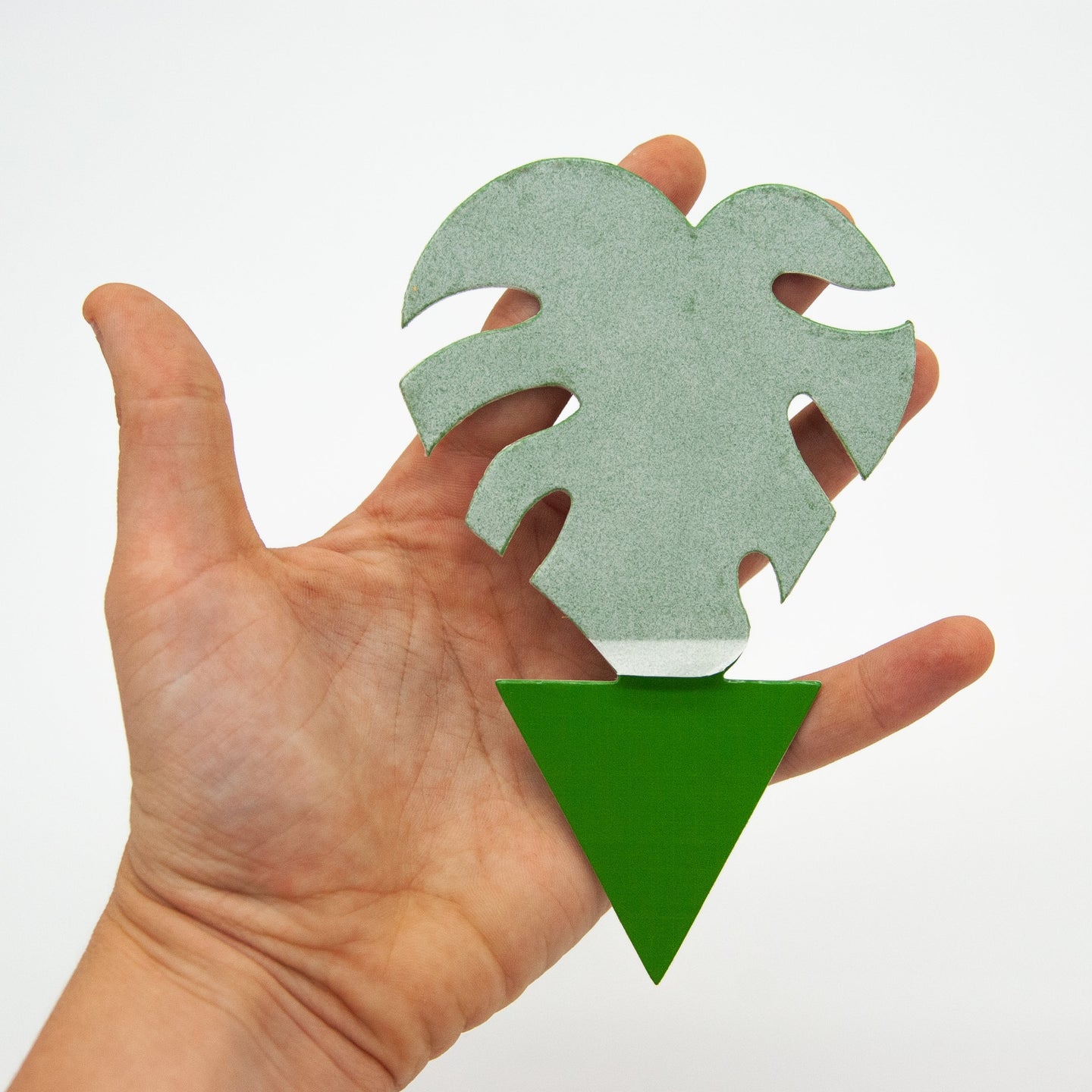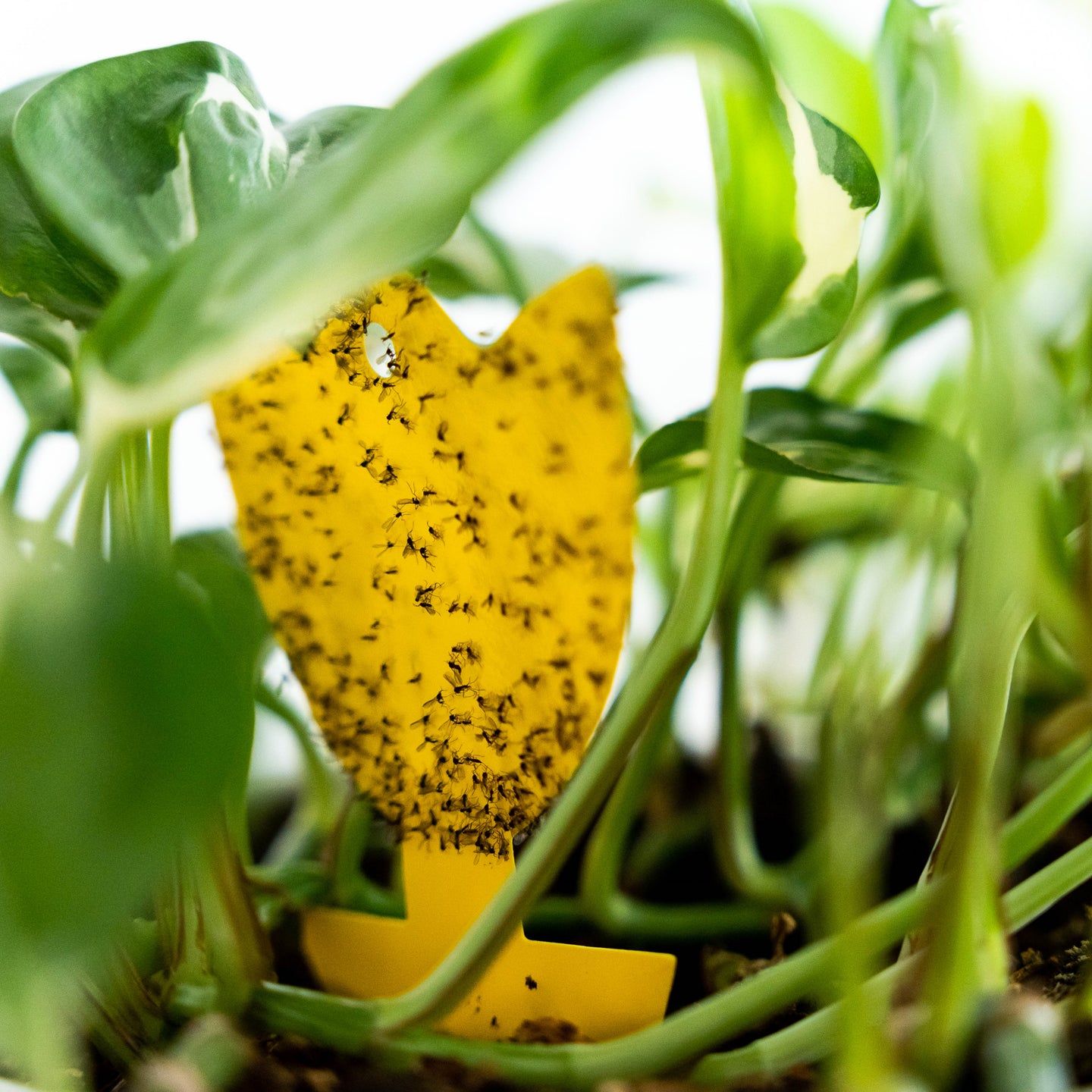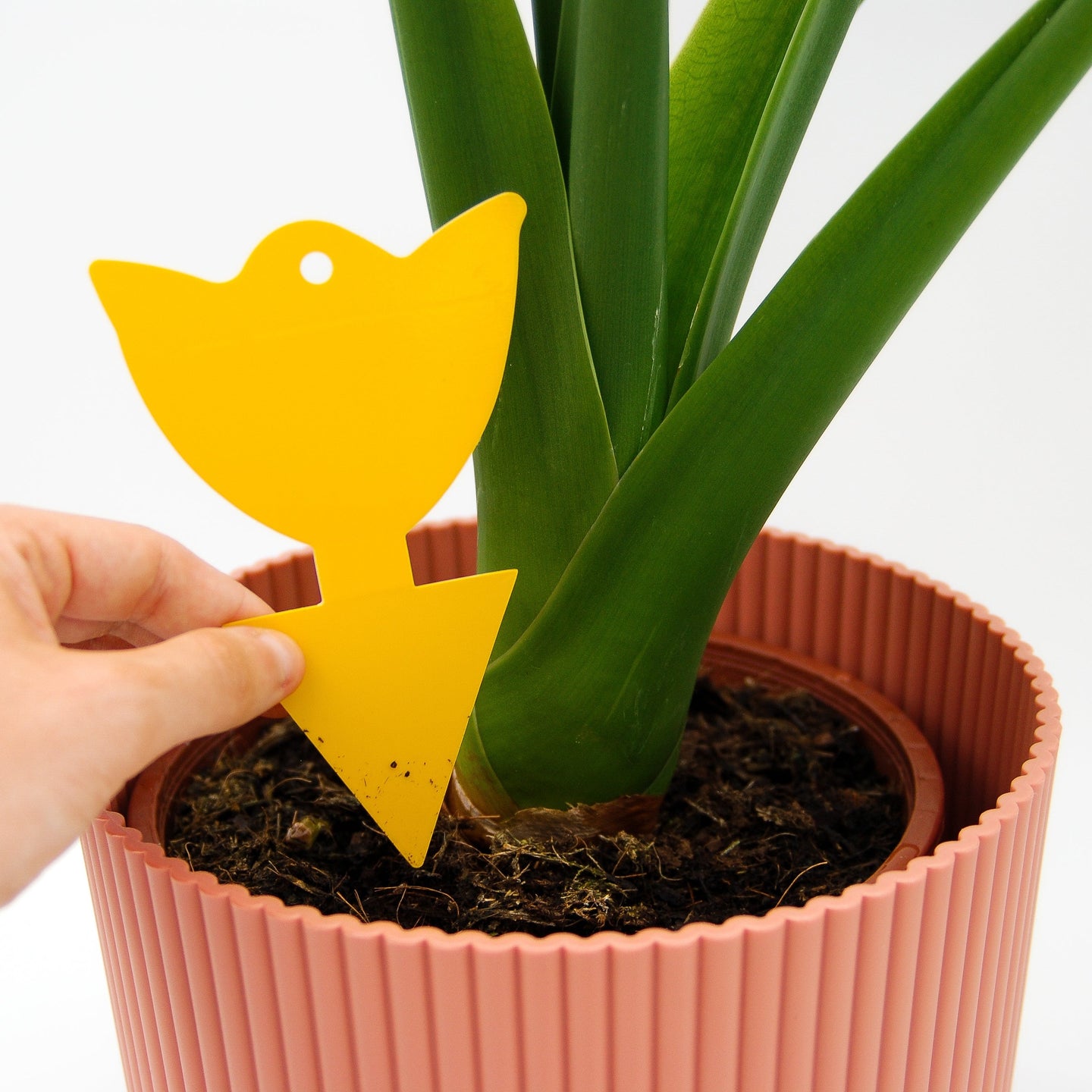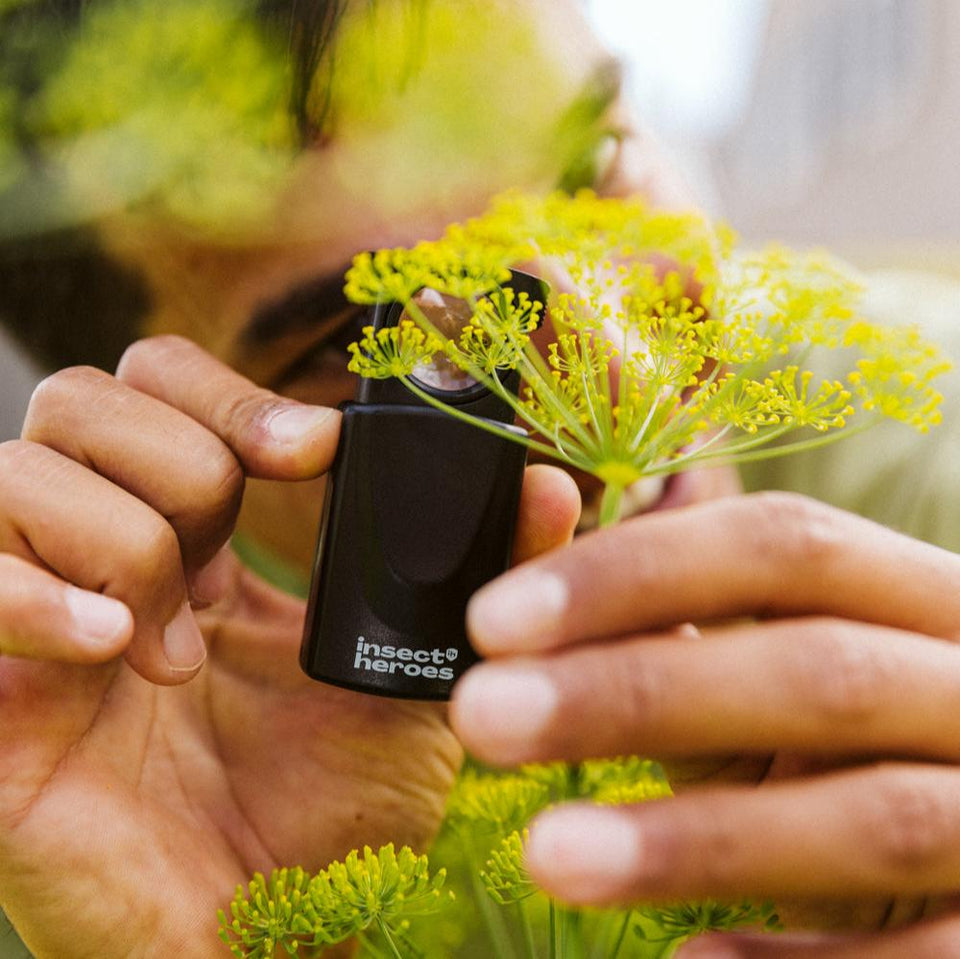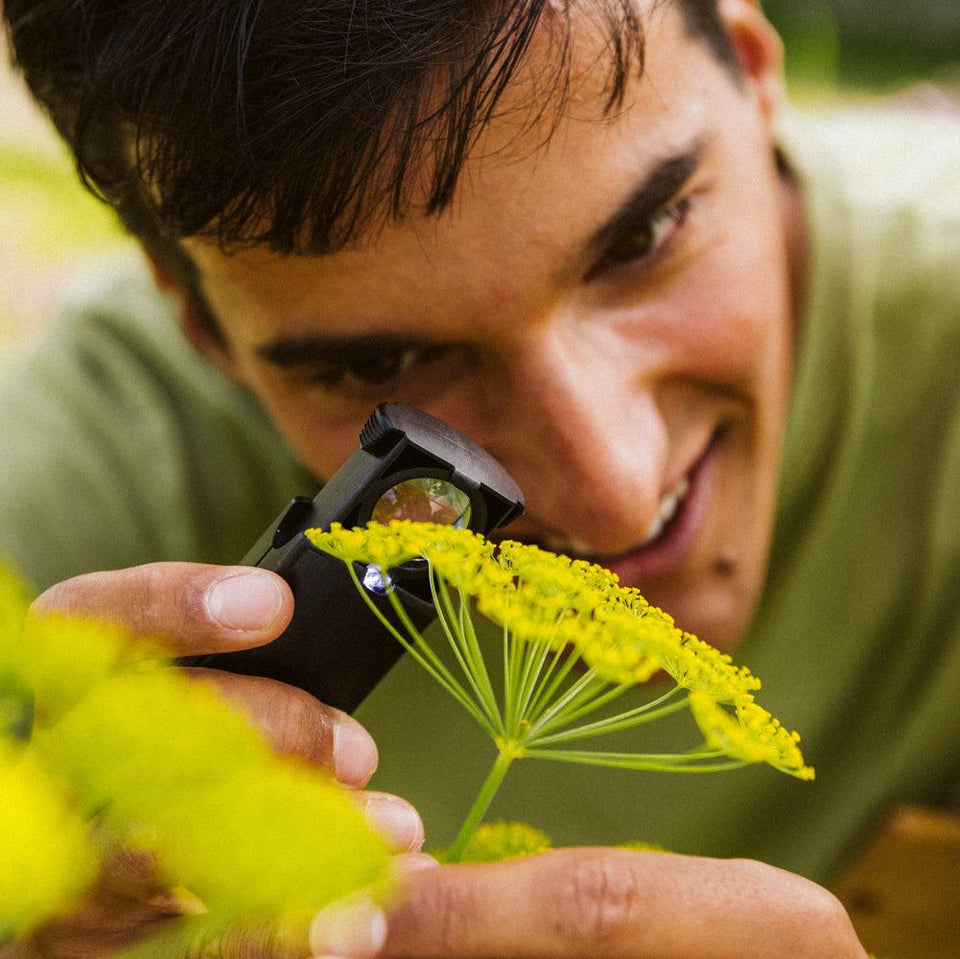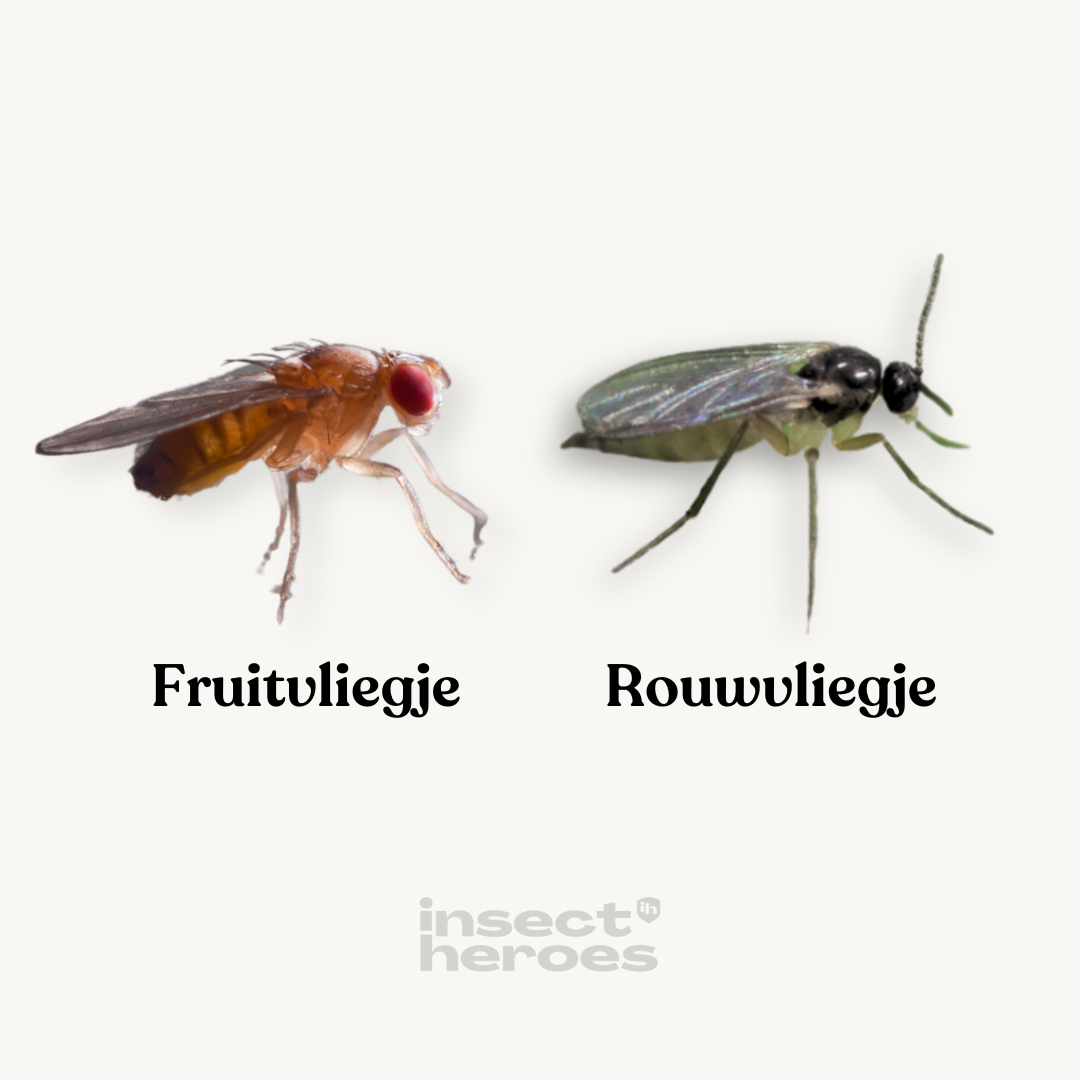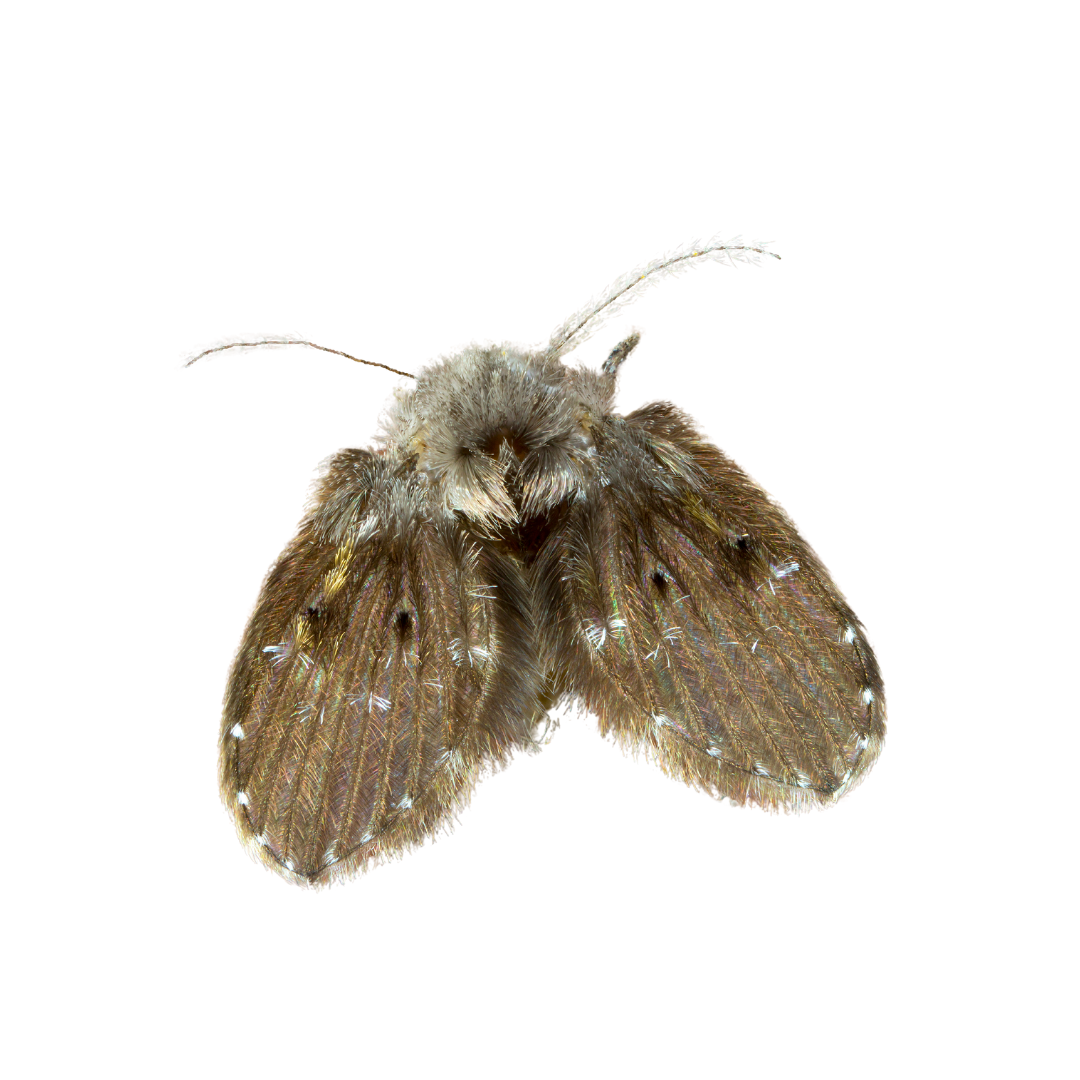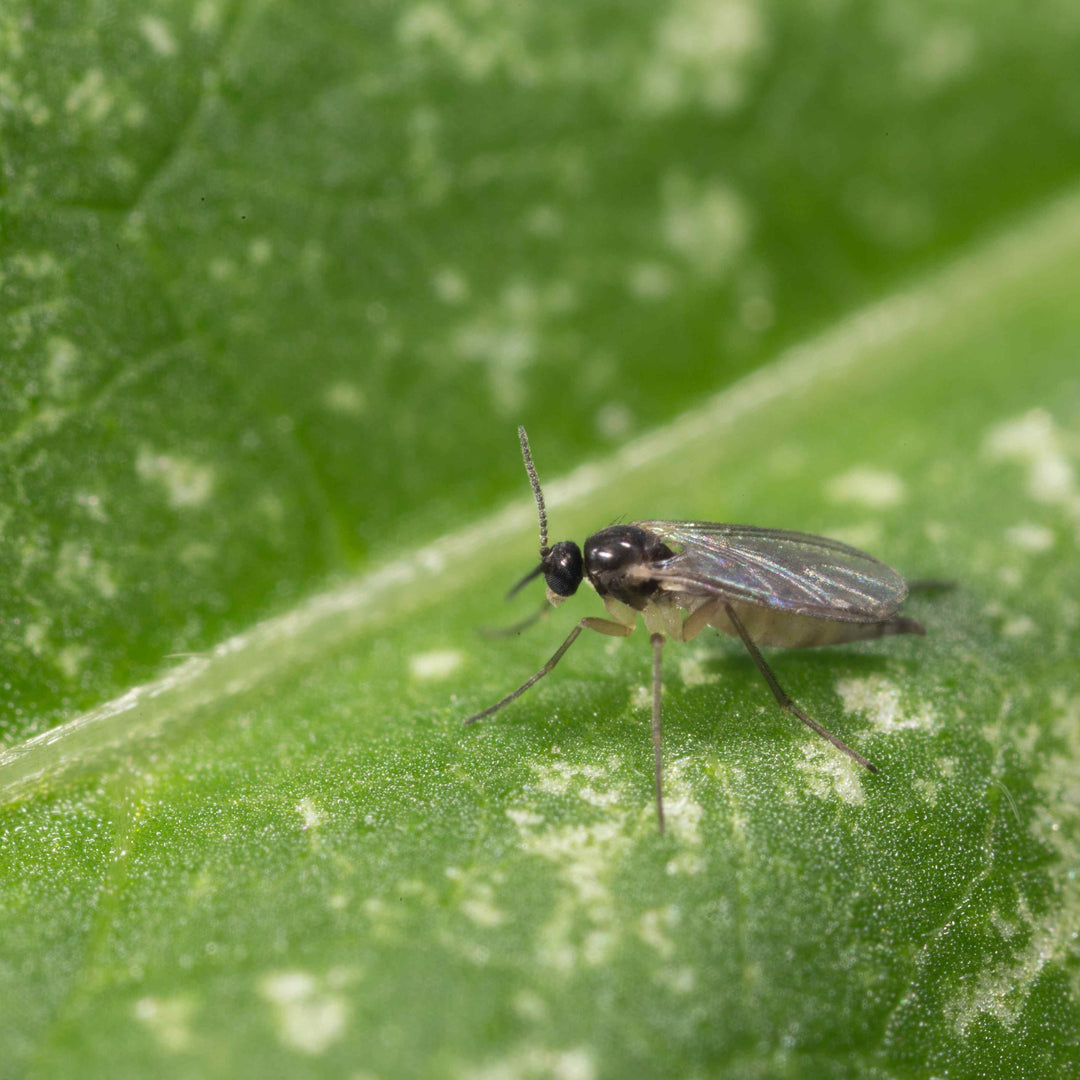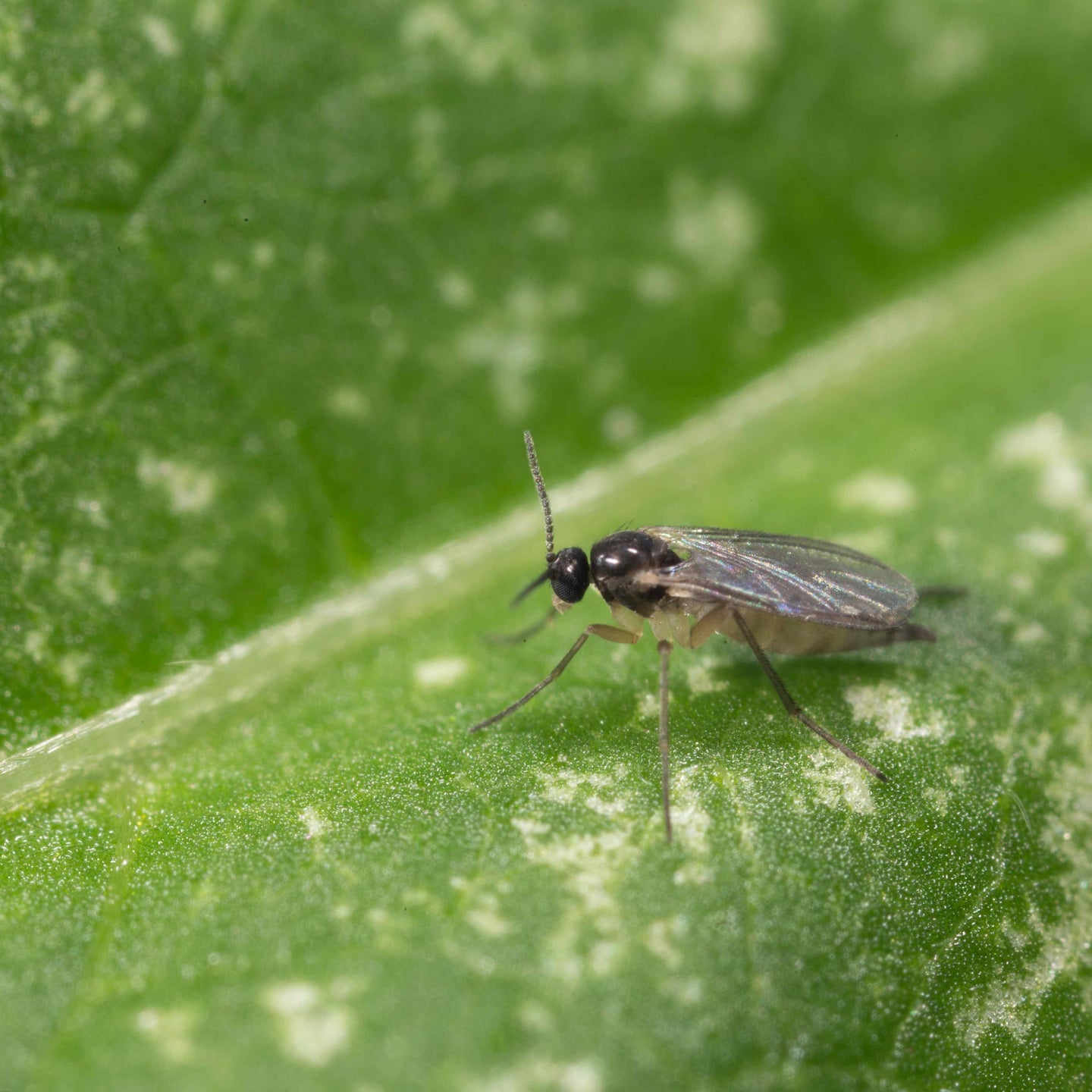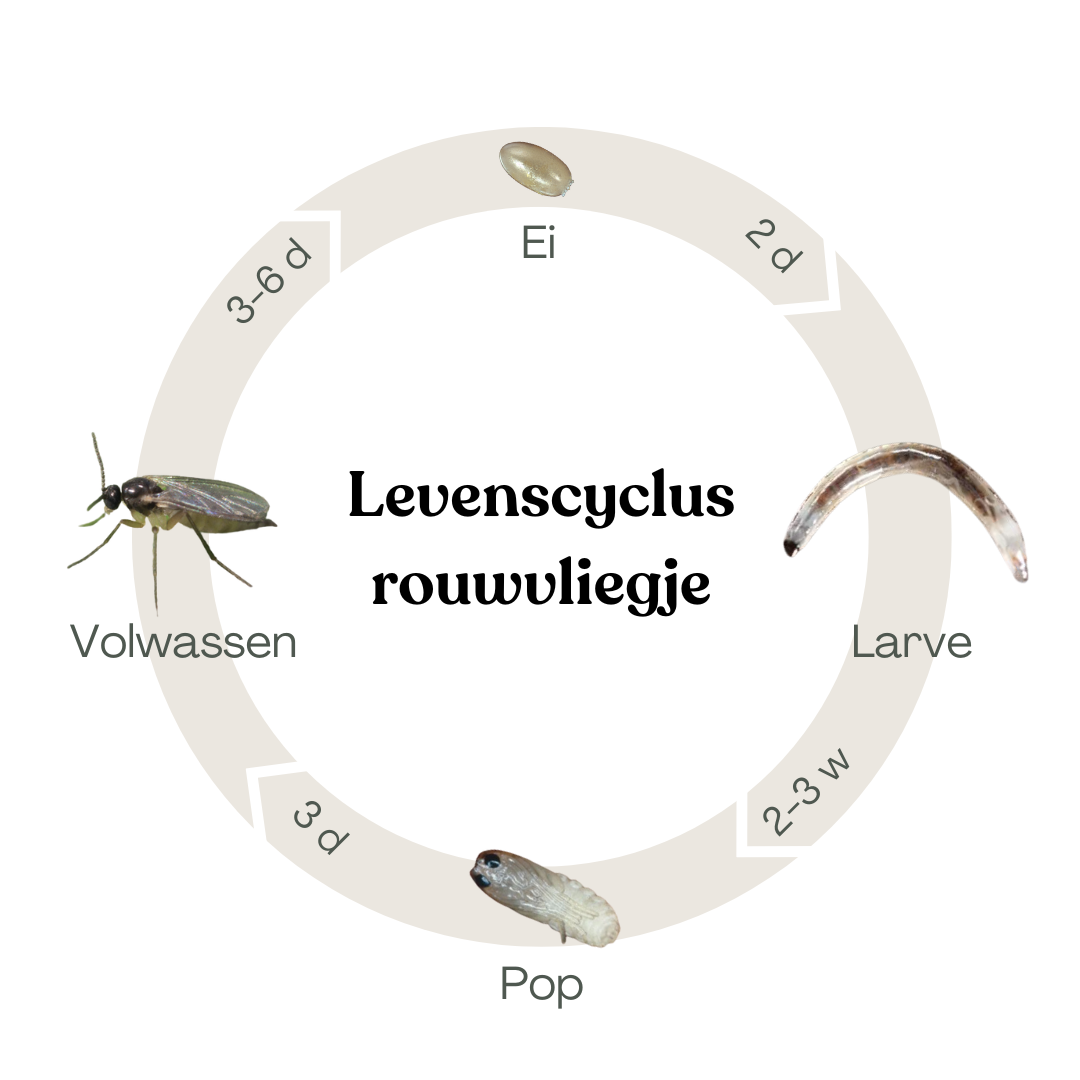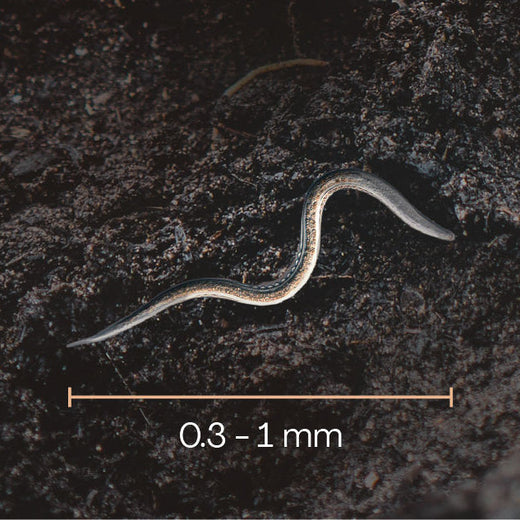Recognize, combat and prevent fungus flies
Rouwvliegjes herkennen
Heb jij kleine zwarte vliegjes in huis? Grote kans dat je last hebt van rouwvliegen, ook wel varenrouwmuggen genoemd. De rouwvliegjes zijn 2-5 mm groot en vliegen vrij traag. Veel mensen vinden ze lijken op fruitvliegjes. De rouwvliegjes vliegen graag rondom kamerplanten, op zoek naar een fijn plekje om hun eieren af te zetten. Je vindt ze dan ook veel rondom de aarde van planten.
De larven van rouwvliegjes leven onder de grond. Ze zijn 5-12 mm groot, doorzichtig van kleur en hebben een zwarte kop en geen pootjes.
Rouwvliegjes ontwikkeling
Rouwvliegjes ontwikkelen zich relatief snel. Een volwassen rouwvliegje leeft maar 1 week en kan gedurende deze week tot wel 300 nieuwe eitjes leggen. Uit het eitje kruipt na 2 dagen een larve. De larve leeft ondergronds en eet organisch materiaal. Als de larven genoeg gegeten hebben verpoppen de larven tot volwassen rouwvliegjes. Het popstadium duurt een paar dagen. In totaal duurt de ontwikkeling van ei tot volwassen rouwvliegje bij kamertemperatuur ongeveer 25 dagen.
Rouwvliegjes schade
De volwassen rouwvliegjes met vleugeltjes zijn onschuldig en doen je plant geen vlieg kwaad! De larven daarentegen leven in de grond en eten organisch materiaal. Dit betekent dat ze afgevallen blaadjes verteren, schimmels en bacteriën eten en dus ook een hapje van de wortels van je plant lusten.
Voor sterke, gezonde planten zijn de rouwvliegjes vaak geen grote bedreiging. Verzwakte of kleine plantjes zoals stekjes zijn wel gevoelig voor de aantasting van de larven van rouwvliegen. Veel mensen vinden de volwassen rouwvliegjes ook niet fijn in huis en willen daarom de beestjes bestrijden.
Rouwvliegjes bestrijden op natuurlijke wijze
Rouwvliegjes kun je eenvoudig en effectief bestrijden met twee verschillende producten: Felti aaltjes en Sticky Leaf vangkaartjes. Zo pak je alle levensstadia van de rouwvlieg aan. Beide producten worden ook in een Combi Pakket aangeboden.
Larven van rouwvliegjes bestrijden
De larven van rouwvliegjes kunnen eenvoudig worden bestreden met Felti aaltjes. Aaltjes zijn microscopische wormen die de larven van rouwvliegjes parasiteren, waardoor ze sterven. Het Felti product wordt geleverd in een klei-achtige substantie die je kan oplossen in water. Giet de oplossing van aaltjes en water over de potgrond en de aaltjes doen al het werk.
Volwassen rouwvliegjes bestrijden
Volwassen rouwvliegjes kunnen worden bestreden door ze te vangen met grote of kleine vangplaten. Door de aantrekkelijke kleur worden de rouwvliegjes aangetrokken en door de sterke lijm kunnen ze niet meer ontsnappen. De vangplaten zijn geurloos en bevatten geen giftige stoffen. Vangplaten zijn ideaal om de plaag goed te monitoren. Je ziet snel of je te maken hebt met een plaag en kan daardoor tijdig actie ondernemen door Felti aaltjes uit te zetten.
Rouwvliegjes voorkomen
Je kunt rouwvliegjes voorkomen door de omgeving minder gunstig te maken voor de larven van rouwvliegjes en door natuurlijke vijanden preventief in te zetten.
Quarantaine
Rouwvliegjes kunnen op meerdere manieren in je planten belanden. Vaak zijn nieuw-aangeschafte planten besmet met eitjes of larven van rouwvliegen. Daarom is het aan te raden de nieuwe planten een paar dagen apart te zetten in een kamer of eventjes buiten te zetten.
Afwatering planten verbeteren
Let bij je (kamer)planten goed op de afwatering van de pot. Bij veel planten geldt dat als de wortels te lang in water staan, ze bruin worden en gaan rotten. Dit noem je wortelrot. De larven van de rouwvliegjes houden erg van schimmels en een natte omgeving. Til de binnenpot van de plant af en toe op. Zo kan je inspecteren of de wortels mooi wit van kleur zijn en er gezond uit zien. De vochtigheid kan je controleren door middel van een vochtmeter of voelen door een vinger diep in de aarde te drukken.
In geval van potten in de tuin of op balkon geldt: zorg dat er gaatjes onderin de pot zitten waardoor het water niet in de pot blijft staan.
Aaltjes en vangkaartjes preventief inzetten
Een effectieve manier om rouwvliegjes te voorkomen is door preventief Felti aaltjes bij te planten te voegen. Voeg de aaltjes toe aan de hoeveelheid water die je normaal aan de plant geeft.
Door vangkaartjes in de aarde te steken, kan je goed monitoren of er rouwvliegjes rond de planten vliegen en kan je ze snel wegvangen.
Andere manieren om rouwvliegjes te bestrijden
Rouwvliegjes bestrijden met mierenpoeder of andere chemische middelen
Er zijn veel verschillende anti-insectenmiddelen op de markt die claimen 100% natuurlijk, ecologisch of biologisch te zijn. Helaas kunnen deze middelen toch giftige, van oorsprong natuurlijke stoffen bevatten. Het probleem met deze producten is dat ze heel algemeen en effectief insecten doden die ermee in aanraking komen.
Als het bijvoorbeeld buiten wordt gebruikt kan het van de bladeren spoelen en in water terechtkomen. De giftige stoffen kunnen schadelijk zijn voor beestjes die leven in het water. Ook voor huisdieren, kinderen of je eigen gezondheid zijn deze middelen niet fijn. Kijk op de verpakking altijd naar de samenstelling. Let op giftige stoffen zoals pyrethrinen, deltamethrin of acetamiprid en vermijd deze liever.
Rouwvliegjes bestrijden met kaneel
Sommige mensen bestrijden rouwvliegjes door kaneel te mengen met kokend water. Dit mengsel wordt nadat het afgekoeld is bij de planten gegoten. Deze techniek wordt ook wel met tijm toegepast. De kruiden zouden dan een afwerende werking hebben.
Rouwvliegjes bestrijden met koffie
Door koffieprut over de potgrond te verdelen, verjaag je de volwassen rouwvliegjes. Door de sterke geur leggen ze liever geen eitjes in de potgrond. Met deze techniek bestrijd je niet de larven van rouwvliegjes in de potgrond.
Rouwvliegjes bestrijden met knoflook
Door knoflookteentjes in de plant te zetten zorg je ervoor dat de rouwvliegjes minder graag eitjes in de potgrond leggen. Voor jezelf is dit helaas ook geen fijne lucht! De knoflook zorgt er niet voor dat de larven van de rouwvliegjes bestreden worden of verdwijnen.
Weet je niet zeker van welke plaag je last hebt?
Bekijk de overzichtspagina met alle plagen.


















































